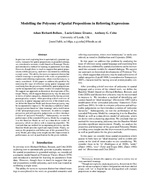Modelling the Polysemy of Spatial Prepositions in Referring Expressions
From International Center for Computational Logic
Modelling the Polysemy of Spatial Prepositions in Referring Expressions
Adam Richard-BollansAdam Richard-Bollans, Lucía Gómez ÁlvarezLucía Gómez Álvarez, Anthony CohnAnthony Cohn
Adam Richard-Bollans, Lucía Gómez Álvarez, Anthony Cohn
Modelling the Polysemy of Spatial Prepositions in Referring Expressions
In Diego Calvanese, Esra Erdem, Michael Thielscher, eds., Proceedings of the 17th International Conference on the Principles of Knowledge Representation and Reasoning (KR'20), 2020. IJCAI Organization
Modelling the Polysemy of Spatial Prepositions in Referring Expressions
In Diego Calvanese, Esra Erdem, Michael Thielscher, eds., Proceedings of the 17th International Conference on the Principles of Knowledge Representation and Reasoning (KR'20), 2020. IJCAI Organization
- KurzfassungAbstract
In previous work exploring how to automatically generate typicality measures for spatial prepositions in grounded settings, we considered a semantic model based on Prototype Theory and introduced a method for learning its parameters from data. However, though there is much to suggest that spatial prepositions exhibit polysemy, each term was treated as exhibiting a single sense. The ability for terms to represent distinct but related meanings is unexplored in the work on grounded semantics and referring expressions, where even homonymy is rarely considered. In this paper we address this problem by analysing the issue of reference using spatial language and examining how the polysemy exhibited by spatial prepositions can be incorporated into semantic models for situated dialogue. We support our approach on theoretical developments of Prototype Theory, which suggest that polysemy may be analysed in terms of radial categories, characterised by having several prototypicality centres. After providing a brief overview of polysemy in spatial language and a review of the related work, we define the Baseline Model and discuss how polysemy may be incorporated to improve it. We introduce a method of identifying polysemes based on `ideal meanings' and a modification of the `principled polysemy' framework. In order to compare polysemes and aid typicality judgements we then introduce a notion of `polyseme hierarchy'. Subsequently, we test the performance of the extended Polysemy Model by comparing it to the Baseline Model as well as a data-driven model of polysemy which we derive with a clustering algorithm. We conclude that our method for incorporating polysemy into the Baseline Model provides significant improvement. Finally, we analyse the properties and behaviour of the generated Polysemy Model, providing some insight into the improvement in performance, as well as justification for the given methods. - Forschungsgruppe:Research Group: Computational LogicComputational Logic
@inproceedings{R{C2020,
author = {Adam Richard-Bollans and Luc{\'{\i}}a G{\'{o}}mez {\'{A}}lvarez
and Anthony Cohn},
title = {Modelling the Polysemy of Spatial Prepositions in Referring
Expressions},
editor = {Diego Calvanese and Esra Erdem and Michael Thielscher},
booktitle = {Proceedings of the 17th International Conference on the
Principles of Knowledge Representation and Reasoning (KR'20)},
publisher = {IJCAI Organization},
year = {2020}
}
